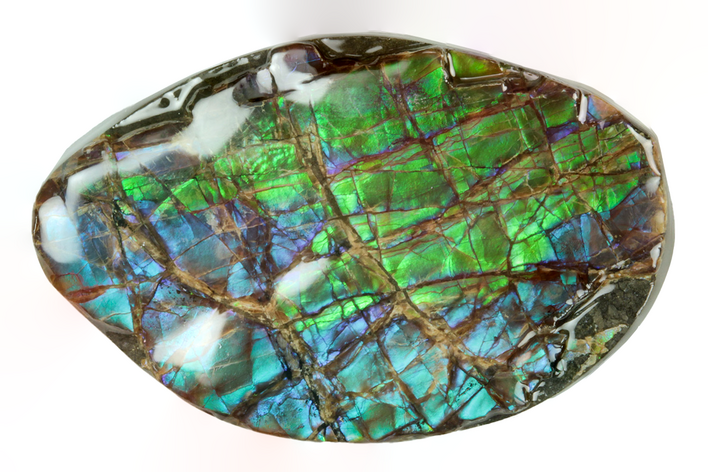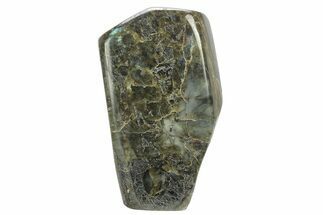This Specimen has been sold.
1.38" Iridescent Ammolite (Fossil Ammonite Shell) - Greens/Blues/Purple
This is a 1.38" wide section of precious ammolite from the Bear Paw Shale of Southern Alberta. It shines with brilliant, iridescence that changes as you view it from different angles.
About Ammolite
Ammolite is an opal-like gemstone found primarily in Alberta, Canada. It is a kind of fossilized shell from ammonites, which in turn are composed primarily of aragonite, the same mineral contained in nacre (mother-of-pearl). The shell's microstructures are often preserved. In 1981, ammolite was given official gemstone status by the World Jewellery Confederation (CIBJO).
An iridescent opal-like play of color is shown in fine specimens, mostly in shades of green and red; howver, all the spectral colors can be seen. This iridescence is due to the aragonite's microstructure: unlike most other gems, whose colors come from light absorption, the iridescence in ammolite comes from interference with the light that rebounds from stacked layers of thin platelets that make up the aragonite. The thicker the layers, the more reds and greens are produced; the thinner the layers, the more blues and violets predominate. Blues and especially purples are the rarest colors, owing to the greater fragility of the finer layers responsible for these colors.
Ammolite is an opal-like gemstone found primarily in Alberta, Canada. It is a kind of fossilized shell from ammonites, which in turn are composed primarily of aragonite, the same mineral contained in nacre (mother-of-pearl). The shell's microstructures are often preserved. In 1981, ammolite was given official gemstone status by the World Jewellery Confederation (CIBJO).
An iridescent opal-like play of color is shown in fine specimens, mostly in shades of green and red; howver, all the spectral colors can be seen. This iridescence is due to the aragonite's microstructure: unlike most other gems, whose colors come from light absorption, the iridescence in ammolite comes from interference with the light that rebounds from stacked layers of thin platelets that make up the aragonite. The thicker the layers, the more reds and greens are produced; the thinner the layers, the more blues and violets predominate. Blues and especially purples are the rarest colors, owing to the greater fragility of the finer layers responsible for these colors.
SPECIES
Placenticeras sp.
LOCATION
Korite Ammolite Mine, SW Alberta, Canada
FORMATION
Bearpaw Formation
SIZE
1.38" wide
CATEGORY
ITEM
#243020
We guarantee the authenticity of all of our specimens.
 Reviews
Reviews











